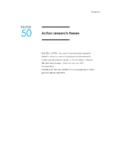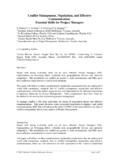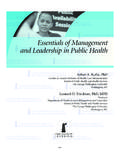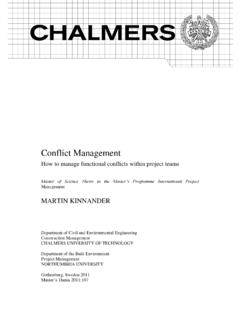Transcription of PAPER 25 Management of conflict - Bob Dick
1 PAPER 25 - 1 Management of conflict Bob Dick (1987) The Management of conflict : a systematic approach to team building and mediated and unmediated conflict resolution . Chapel Hill: Interchange (mimeo).A 1987 revision of a 1981 PAPER , written to support workshops in conflict Management . More details of the PAPER s provenance are given in the preface. Some of the references to earlier documents have been updated Preface This document 1 describes fairly robust (or do-it-yourself ) versions of team-building and conflict resolution. The robustness comes from a number of sources. One is the use of some techniques which keep the problem small and containable.
2 A second is the use of a number of detailed procedures and is a living document which is often revised, and portions of which have appeared in other documents and handouts. PAPER 25 PAPER 25 - 2 Robust processes papers frameworks which makes it easier for a mediator to keep on track. An explicit problem-solving approach is used, which increases many users acceptance of the method. A third is the inclusion of simple communication skills training (for mediator, or those in conflict , or both) as part of the the most important source of its robustness is the use of a procedure which more nearly resembles role negotiation than conflict resolution.
3 This is made possible by the use of criteria to decide what information needs to be exchanged. Thus a typical session might begin as role negotiation. When the need arises, it might then become more of a relationship-oriented team building session by the addition of the extra relevant information. For more complex issues, it might respond by becoming something quite similar to the approach described by Chris Argyris in some of his writing. In this third form, it is characterised by the inclusion of information about beliefs, not given specific attention in many elements of the system, and the communication skills which form part of it, are supported by practical and intuitively-satisfying conceptual models.
4 The more experienced user can therefore amend the procedures to use her [I use feminine gender throughout to refer to either sex] own skills and preferred you might imagine, there are advantages in having a technique which starts with role negotiation but which can move easily into conflict resolution when that is useful. The technique also uses a combination of consensus and negotiation. Consensus is more powerful when it can be used. Negotiation has wider applicability. The use of both gains the advantages of document begins with a thumbnail sketch of the approach. Then follow the major sections on communication skills, mediation ( conflict resolution with a third party), and unmediated conflict resolution (when the person conducting the conflict resolution is one of the parties to the conflict ).
5 Later parts of the document address such issues as preventive measures using organisational Management of conflictPaper 25 - 3 restructuring, and use of the technique as part of a team building programme. A final section discusses how the technique can be varied to suit the wrote the document for three main types of reader. My central intention was to describe material which could be used to help train intending consultants and trainers. I required such material for my teaching at the University of Queensland and elsewhere. I have also included procedures which can be used by experienced consultants and trainers to extend their skills in the areas of teambuilding and conflict Management .
6 It is also my hope that the material will be used by other people to maintain and enrich the relationships that are important to them this might include parents, managers, and members of community present approach owes much to those people I have worked with in the past. These include managers and other people from consulting assignments, and people who have studied conflict resolution with me in university courses and elsewhere. I thank them for early version of part of this document appeared in May 1981. I prepared it for the Association for Gifted and Talented Children, for whom I ran some work-shops on parent-teenager conflict resolution.
7 The PAPER was titled Parents: how to live more-or-less happily with a teenager, or Teenagers: how to live more-or-less happily with a parent . It focussed on mediated and unmediated conflict resolution. This PAPER was revised into something more closely resembling its present form in 1983, under the title The Management of conflict (unpublished mimeo, Department of Psychology, University of Queensland, 1983), for distribution at the Melbourne OD Networks conference Seminar 83 . PAPER 25 - 4 Robust processes papers The ideas on mediated conflict resolution were further developed for a skills teaching workbook Communication skills workbook (University of Queensland, Department of Psychology, 1983, 1984).
8 I thank Cindy Gallois, Joe McDowall and Debbie Twinn for their help in developing it. This has since been revised and reissued as a joint Interchange and University Bookshop publication under the title Learning to communicate (1986; available from the University of Queensland Bookshop).I owe too much to too many other people to mention them all. Some of my many other debts have been acknowledged in earlier documents. I would like, however, to single out my fellow member of the Centre of Applied Behavioural Science: George Blackgrove, John Damm, Phil Hanford, Hollis Peter, and Garth of the ideas on structure were developed in conversation with Dexter Dunphy, when I helped him to prepare the book Organisational change by choice (McGraw-Hill Australia, 1981.)
9 The approach to team building is based on some work I did with local organisations beginning in the mid 1970 s. An earlier form was described in the PAPER Team building: Face to face communication and some procedures for improving it (Unpublished mimeo, Institutions of Engineers, Australia, Queensland Division, 1977). It has also benefitted from talks with Rob Skerman, who used it as a basis for his internal Public Service Board document A manager s guide to teambuilding: A role negotiation model (Unpublished mimeo, Metropolitan Hospitals Board, undated). I was also influenced by conversations I had with Jim Hirsch of Department of Primary Industry, who has used his own role-based procedures within that ideas of problem solving have developed simultaneously with those on communication skills.
10 They were helped to take firmer shape in the course of preparing (with Hollis Peter) a workbook for the Department of Employment Management of conflictPaper 25 - 5 and Industrial Relations, Implementing participative personnel practices (Department of Employment and Industrial Relations, 1985). This addresses the design and redesign of personnel practices using a set of techniques for partici-pative Management of categorisation into first and second person skills I owe to Paul Donovan, until recently with the Australian Institute of Management in Brisbane. Many people have helped me develop this system. The appropriate acknowledgments are given in my monograph Communication skills (Organisational Studies Unit, University of Queensland, 1979), available from the Department of Management at the University, perhaps to be revised during 1987 or 1988.









